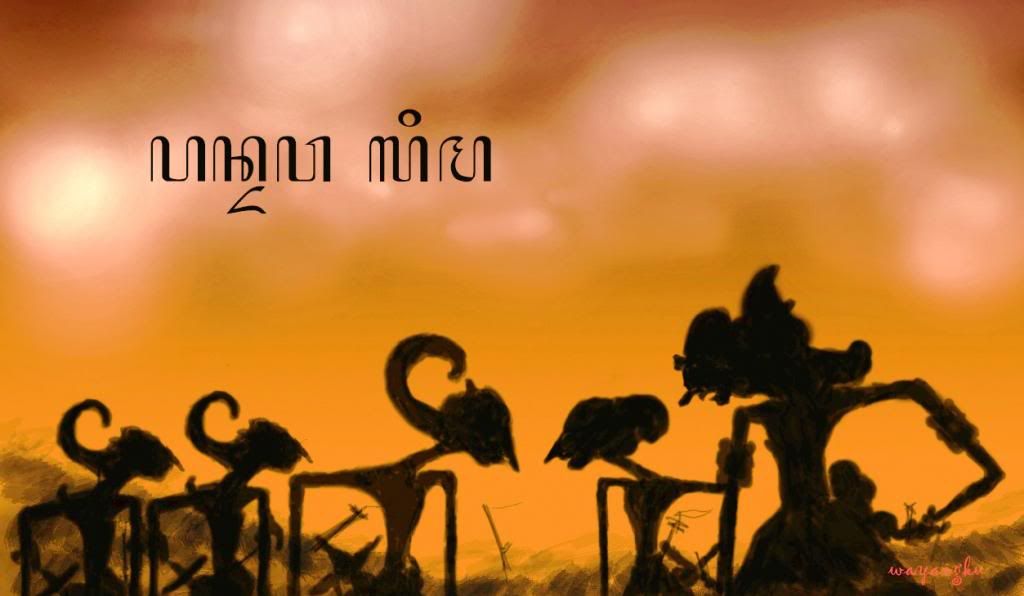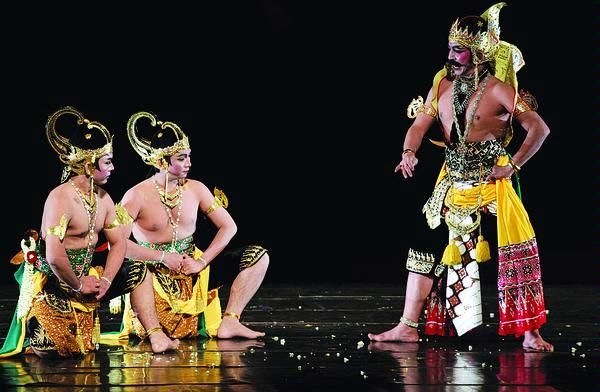WAYANG KULIT
Wayang kulit, or shadow puppets, are without a doubt the best known of the Indonesian wayang. Kulit means skin, and refers to the leather construction of the puppets that are carefully chiselled with very fine tools and supported with carefully shaped buffalo horn handles and control rods. The stories are usually drawn from the Hindu epics the Ramayana, the Mahabharata or from the Serat Menak, (a story about the heroism of Amir Hamza).
There is a family of characters in Javanese wayang called Punakawan; they are sometimes referred to as "clown-servants" because they normally are associated with the story's hero, and provide humorous and philosophical interludes. Semar is the father of Gareng (oldest son), Petruk, and Bagong (youngest son). These characters did not originate in the Hindu epics, but were added later, possibly to introduce mystical aspects of Islam into the Hindu-Javanese stories.[6] They provide something akin to a political cabaret, dealing with gossip and contemporary affairs.
The puppet figures themselves vary from place to place. In Central Java the city of Surakarta (Solo) and city of Yogyakarta are most famous and the most commonly imitated style of puppets. Regional styles of shadow puppets can also be found in West Java, Banyumas, Cirebon, Semarang, and East Java. Bali produces more compact and naturalistic figures, and Lombok has figures representing real people. Often modern-world objects as bicycles, automobiles, airplanes and ships will be added for comic effect, but for the most part the traditional puppet designs have changed little in the last 300 years.
Historically, the performance consisted of shadows cast on a cotton screen and an oil lamp. Today, the source of light used in wayang performance in Java is most often a halogen electric light. Some modern forms of wayang such as Wayang Sandosa created in the Art Academy at Surakarta (STSI) has employed spotlights, colored lights and other innovations.
The handwork involved in making a wayang kulit figure that is suitable for a performance takes several weeks, with the artists working together in groups. They start from master models (typically on paper) which are traced out onto skin or parchment, providing the figures with an outline and with indications of any holes that will need to be cut (such as for the mouth or eyes). The figures are then smoothed, usually with a glass bottle, and primed. The structure is inspected and eventually the details are worked through. A further smoothing follows before individual painting, which is undertaken by yet another craftsman. Finally, the movable parts (upper arms, lower arms with hands and the associated sticks for manipulation) mounted on the body, which has a central staff by which it is held. A crew makes up to ten figures at a time, typically completing that number over the course of a week. However, unfortunately there is not strong continuing demand for the top skills of wayang craftspersons and the relatively few experts still skilled at the art sometimes find it difficult to earn a satisfactory income.
The painting of less expensive puppets is handled expediently with a spray technique, using templates, and with a different person handling each color. Less expensive puppets, often sold to children during performances, are sometimes made on cardboard instead of leather.
Wayang wong and wayang topeng
Wayang wong also known as Wayang orang (literally "human wayang") is a type of Javanese theatrical performance with themes taken from episode of Ramayana or Mahabharata.
While wayang gedog usually the theatrical performance that took the themes from the Panji cycles stories from the kingdom of Janggala, in which the players wear masks known as wayang topeng or wayang gedog. The word gedog comes from kedok, which, like topeng means "mask". The main theme is the story of Raden Panji and Candra. This is a love story about princess Candra Kirana of Kediri and Raden Panji Asmarabangun, the crown prince of Jenggala. Candra Kirana was the incarnation of Dewi Ratih (goddess of love) and Panji was an incarnation of Kamajaya (god of love). Kirana's story was given the title Smaradahana ("The fire of love"). At the end of the complicated story they finally can marry and bring forth a son, named Raja Putra. Panji Asmarabangun ruled Jenggala under the official names Sri Kameswara, Prabu Suryowiseso, and Hino Kertapati. Originally, wayang wong was performed only as an aristocratic entertainment in four palaces of Yogyakarta and Surakarta. In the course of time, it spread to become a popular and folk form as well.
Wayang golek
Wayang golek are wooden doll puppets that are operated from below by rods connected to the hands and a central control rod that runs through the body to the head. The simple construction of the puppets belies their versatility, expressiveness and aptitude for imitating human dance. Today, wayang golek is mainly associated with Sundanese culture of West Java. However the wooden wayang also known in Central Java as Wayang Menak, originated from Kudus Central Java.
Little is known for certain about the history of wayang golek, but scholars have speculated that it most likely originated in China and arrived in Java sometime in the 17th century. Some of the oldest traditions of wayang golek are from the north coast of Java in what is called the pasisir region. This is home to some of the oldest Muslim kingdoms in Java and it is likely the wayang golek grew in popularity through telling the wayang menak stories of Amir Hamza, the uncle of Muhammad. These stories are still widely performed in Kabumen, Tegal, and Jepara as wayang golek menak, and in Cirebon, wayang golek cepak. Legendary origins of wayang golek attribute their invention to the Muslim saint Wali Sunan Kudus, who used the medium to proselytize Muslim values.
In the 18th century the tradition moved into the mountainous region of Priangan West Java where it eventually was used to tell stories of the Ramayana and the Mahabarata in a tradition now called Wayang Golek Purwa, which can be found in Bandung, Bogor and Jakarta. The adoption of Javanese Mataram kejawen culture by Sundanese aristocrats was probably the remnant of Mataram influence over the Priangan region during the reign of expansive Sultan Agung. While main characters from Ramayana and Mahabharata are similar with wayang kulit purwa version of Central Java, some of punakawan (servant also jester) were rendered in Sundanese names and characteristics, such as Cepot or Astrajingga as Bagong, Dawala or Udel as Petruk. Wayang golek purwa has become the most popular form of wayang golek today and the most famous puppeteer family is the Sunarya family which has produced several generations of stellar performers.




EmoticonEmoticon